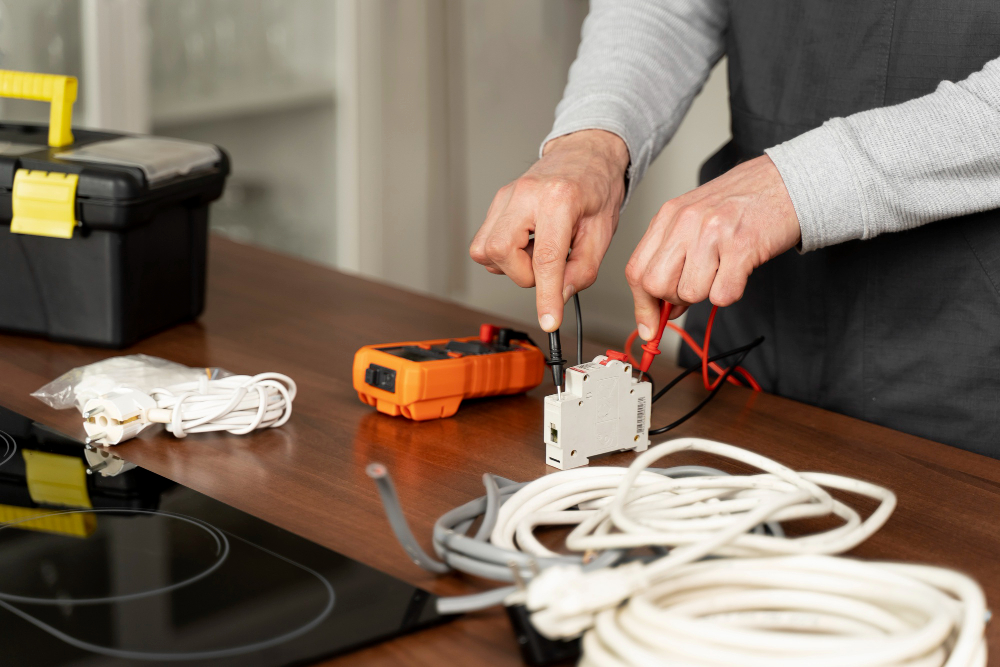IntroductionElectrical Issues at Home
Electrical problems can be a significant inconvenience and sometimes a safety hazard in your home. Understanding how to troubleshoot common electrical issues can save you time, money, and potential frustration. In this guide, we’ll cover essential troubleshooting tips and solutions for the most frequent electrical problems you might encounter. Whether you’re dealing with flickering lights, tripped breakers, or faulty outlets, this blog will help you address these issues effectively.
1. Understanding Common Electrical Problems
1. Flickering Lights
Cause: Flickering lights are often caused by loose light bulbs, faulty light switches, or issues with the wiring.
Solution: Start by checking if the light bulb is securely fitted. If the problem persists, the issue might be with the light switch or wiring, which may require professional inspection.
2. Tripped Circuit Breakers
Cause: A circuit breaker trips when there’s an overload or a short circuit. This is a safety measure to prevent electrical fires.
Solution: Identify the appliance or device causing the overload and reduce the load on the circuit. Reset the breaker once you’ve removed the overload. If the breaker trips again, consult an electrician to inspect for underlying issues.
3. Faulty Outlets
Cause: Outlets that don’t work may be due to loose wiring, damaged receptacles, or faulty connections.
Solution: Check if the outlet is properly connected and replace any damaged parts. If you suspect a wiring issue, it’s best to call a professional.
4. Electrical Shocks
Cause: Electrical shocks can result from damaged wiring, improper grounding, or faulty appliances.
Solution: Ensure all wiring is intact and properly grounded. Replace any damaged cables or appliances immediately. For persistent issues, seek professional help.
2. Basic Electrical Troubleshooting Steps
1. Check for Power Supply
Solution: Verify that the power supply to the circuit is active. Use a voltage tester to ensure there’s electricity flowing to the problematic area.
2. Inspect Wiring Connections
Solution: Loose or corroded connections can cause various electrical issues. Turn off the power and inspect connections for any visible signs of damage or wear.
3. Test Electrical Devices
Solution: Plug a working device into the outlet to see if it functions correctly. This helps determine if the problem lies with the outlet or the device.
4. Reset Circuit Breakers
Solution: If a circuit breaker has tripped, reset it by switching it off and then back on. Ensure that you address the cause of the trip before resetting.
3. Advanced Troubleshooting
1. Finding Faults in House Wiring
Solution: Use a multimeter to test for voltage drops and continuity in wiring. This helps identify breaks or short circuits in the wiring system.
2. Identifying a Faulty Circuit
Solution: Test circuits with a circuit tester to locate issues. Check for consistent power delivery and inspect for overheating or irregular readings.
3. Testing Home Wiring
Solution: Use a circuit analyzer to evaluate the quality of your home wiring. Look for issues such as improper grounding or overloading.
4. Common Electrical Faults and Solutions
1. Poor Grounding
Solution: Ensure that your electrical system is properly grounded to avoid electrical faults and enhance safety.
2. Overloaded Circuits
Solution: Distribute electrical load evenly across circuits and avoid plugging too many devices into a single outlet.
3. Short Circuits
Solution: Inspect for damaged wires or faulty connections that may cause short circuits. Repair or replace the affected wiring.
4. Ground Faults
Solution: Use Ground Fault Circuit Interrupters (GFCIs) to protect against ground faults and ensure proper wiring and grounding.
5. Open Circuits
Solution: Identify and repair any breaks in the circuit path to restore functionality.
5. Safety Tips for Electrical Troubleshooting
- Always turn off the power before inspecting or repairing electrical components.
- Use insulated tools to prevent electrical shock.
- If you’re unsure about any repair or troubleshooting process, contact a licensed electrician.
Conclusion
Troubleshooting electrical issues at home doesn’t have to be daunting. By understanding common problems and following basic troubleshooting steps, you can address many issues yourself. However, always prioritize safety and consult a professional for complex or hazardous problems. For further assistance, contact a local electrician to ensure your home’s electrical system is safe and functioning correctly.


 Your Local Reliable Electrician That You Can Trust
Your Local Reliable Electrician That You Can Trust 